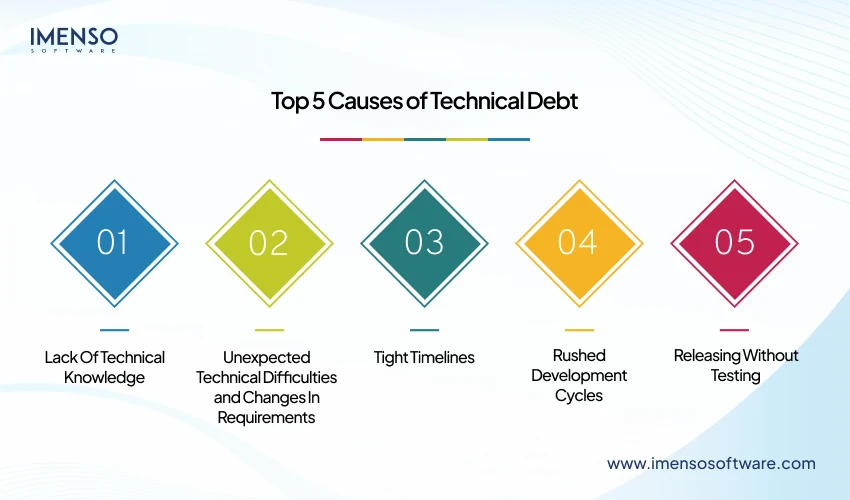How to Reduce Technical Debt in Rapidly Growing Startups?

Perhaps nothing weighs down a flourishing startup like technical debt. Instead of making technology an engine for growth, it makes it a burden. Delivering a quick solution that runs on a less efficient code is in some cases a necessary trade-off to surge ahead in the market.
However, if these types of transactions occur repeatedly, it creates technical debt. Technical debt or the accumulation of shortcuts and compromises in software systems, is an all-pervasive problem across industries. It has disastrous consequences ranging from system failures and security lapses to impeded innovation. The Wall Street Journal reports technical debt as the cause of 13,000 canceled Southwest Airlines flights during the 2022 holiday season. It was also responsible for multiple sophisticated cyberattacks on Google, Apple, and Microsoft.
Forrester’s Q2 2024 Tech Pulse Survey reveals that an alarming 30% of US IT decision-makers struggle with high or critical debt. This growing burden competes with the ability of organizations to pursue new initiatives. Technical debt adversely impacts project delivery and operational resiliency. To stay on the growth track, businesses need to take a proactive approach to reduce technical debt.
Let’s explore some proven ways to reduce technical debt and thrive in the dynamic market.
What Is Technical Debt?
Programmer Ward Cunningham, who co-authored the Agile Manifesto and created Wiki, coined the term ‘technical debt’ in a 1992 article. According to him, while a company may save money in the short run by shipping past versions of code or software, the long-term “interest” from the tech debt naturally accumulates. This, in turn, makes the earlier problem more costly to fix over time.
The simplest way to understand technical debt is by comparing it to financial debt since both are similar.
Startups take on technical debt for reasons similar to why they take on financial debt: We need something urgently that we don’t have the “cash” to pay for in entirety. So we borrow money with software. This translates to making sub-optimal coding or design decisions to get what we want or need into production in significantly less time.
Technical debt, also called code debt or design debt, is a term used in software development. It describes the cost of additional rework caused by initially opting for a quicker delivery over clean, efficient code that would have taken much longer. At its core, technical debt means the compromises made in project speed over following the best coding practices. This leads to the accumulation of ‘debt’ that must eventually be ‘repaid’ with interest, in the form of money, time, and resources.
Technical Debt Examples
A famous example of technical debt is the Year 2000 (Y2K) problem. Developers in the 1960s and 70s chose to store dates as two digits to save memory. So, instead of ‘1973’ the dates were stored as ’73.’ This practice went on even after memory prices declined. The programs became embedded into operational businesses and were used for a long time.
With the arrival of the year 2000, businesses all over realized the fallacy in date calculations, which in turn, led to a rushed (and costly) attempt to clean up. The average cost of addressing the Y2K problem is approximated to $100 million!
Examples of technical debt are also visible beyond the realm of software. In cybersecurity, for example, it is a practice to grant file permissions to roles within the company instead of individuals. For example, an administrative assistant gets approval to access sensitive documents, albeit temporarily. If the IT organization fails to revoke the access later, the individual has permanent access to sensitive documents. The account then becomes highly vulnerable to a security or data breach.
Top 5 Causes of Technical Debt

Knowing the causes of technical debt is important to learn how to avoid them in your own development projects. When you are aware of why technical debt is created and how it impacts teams, you’ll have all the necessary knowledge to shield yourself from falling into this costly trap.
Lack Of Technical Knowledge
In the fast-evolving technical landscape, businesses face a lack of technical knowledge. It prevents the top management and staff from understanding the complexities related to code debt. Most companies don’t invest in technical training and educating their staff on emerging technologies. This, in turn, leads to costly mistakes and missed opportunities.
Unexpected Technical Difficulties and Changes In Requirements
Sudden and unexpected technical difficulties and changes in requirements are another major cause of technical debt. That is why it is so important to factor in this debt to reduce the development costs in the initial stages of project planning. This will prevent debt accumulation due to the addition of more functionalities and uncertainties.
When software developers don’t address technical concerns in the beginning and plan for the worst-case scenarios, the occurrence of unexpected technical challenges or shifts in requirements throughout the project course can lead to technical debt.
Tight Timelines
Tight software development timelines force developers to make trade-offs between perfection and consistency at the time of design. These technical problems accumulate over time and can become difficult or, in some cases, impossible to rectify. It can be more costly to fix technical debt arising from rushed development undertaken with the goal of simply meeting a timeline.
Rushed Development Cycles
Technical debt occurring from technical shortcuts during the software development process is a major problem in rushed development cycles. The rush to finish projects quickly can lead to technical debt that causes the development of poor-functioning applications.
Organizations not taking the time upfront to develop project plans and thoroughly testing solutions throughout the software development lifecycle inevitably waste time addressing technical issues later.
Releasing Without Testing
Releasing code without adequately testing is another cause of technical debt. Developers make quick fixes to a product’s codebase. This results in sloppy coding. It also makes it more challenging to implement future improvements. Technical issues accumulate due to an absence of thorough testing at the time of the release process. It’s always important to follow the best practices for testing and deployment.
How Can Technical Debt Be Reduced?

Organizations grappling with technical debt are unable to scale, innovate, and adapt to the evolving markets. So how to reduce technical debt? Here are some key actions to manage technical debt.
Measure Your Technical Debt
According to a recent study, only 7.2% of organizations measure and track technical debt. Inevitably, these are the very organizations that achieve 50% quicker service delivery times to the business, along with multiple other benefits.
Organizations can the metrics below to measure technical debt through a more objective lens.
- Defect ratios: Software developers can use a tally or ratio of new versus old defects. For example, if there aren’t many new defects and a considerable number of fixed defects, the defect ratio is small. It translates to smaller technical debt. However, if the new defects are greater than the fixes, technical debt is growing.
- Code quality: Cyclomatic and cognitive complexity, maintainability, lines of code, depth of inheritance, afferent (inward) and efferent (outward) couplings, nesting time, and depth when writing code lines to quantify the quality and complexity of code. Declining quality metrics indicate growing technical debt.
- Completion time: The time it takes to complete trouble tickets is also a valuable metric. If developers are spending most of their time doing comparatively simpler tasks, it can point to code or infrastructure trouble.
- Rework or churn: This indicates how many times an infrastructure task or segment of code needs change or rework. Rework, while essential especially in new projects, should fall to almost zero with time. If developers are reworking infrastructure or code in production, they are most likely dealing with technical debt.
- Technical debt ratio (TDR): This ratio compares how much it costs to fix the problems against the overall cost of building the project. An ideal TDR is at around 5%.
Prioritize the Most Critical Debt
Not all technical debt needs to be addressed at once. The key to managing debt effectively is prioritization. Focus on the areas that pose the greatest risk to your system’s stability, scalability, or ability to deliver new features. These can be divided into three sections:
Feature Prioritization is key when it comes to the best way of finding how to reduce technical debt. The most critical areas, where debt can pose the most risk to the software’s scalability and the ability to implement new functionalities are as follows:
- High-risk areas: These are those areas in your codebase with frequent changes and updates. Often technical debt causes the most issues in these areas. With every change, there is a greater possibility of introducing glitches.
- Customer impact: Technical debt that hampers the experience of the end-users needs to be prioritized. Debt that causes user experience issues should be addressed earlier than one with a low impact on the customer.
- ROI-based priorities: Prioritize debt that when resolved will provide the organization with greater ROI and savings.
Improve System Architectural Design
Often, technical debt accumulates due to inefficient system architectures. Companies can eliminate these inefficiencies by improving system architecture. Here are some proven strategies to do so.
Regular Code Refactoring
Refactoring is restructuring existing code without changing its external behavior. With this, you eliminate redundancies and improve the overall quality of the codebase.
- Frequently review and refactor code to reduce technical debt.
- Recognize and prioritize areas of the codebase that need refactoring based on business impact.
- Implement automated testing to ensure changes are implemented during refactoring and do not introduce new glitches.
Bring in Automation
By automating repetitive or error-prone tasks, developers can spend their time and resources to focus on strategic improvements and resolving technical debt.
- Implement automated testing to catch regressions and maintain code quality.
- Implement continuous integration and deployment tools to automate the development and deployment process.
- Use code analysis tools to pinpoint areas of improvement and potential technical debt.
Prioritize Technical Debt Reduction
Identify areas of the architecture design with the most impact on the overall system stability and performance. This approach to technical debt reduction enables developers to proactively address critical issues before they impede future developments.
- Create a prioritization framework to analyze the severity and effect of technical debt.
- Allocate resources and time for tasks related to technical debt reduction.
- Involve stakeholders in the decision-making to gain buy-in for technical debt reduction initiatives.
Collaborative Development and Knowledge Sharing
Establishing coding standards and regularly reviewing the code fosters a culture of shared learning. It helps identify potential design flaws early on and prevent code debt from accumulating.
- Implement code review processes to ensure adherence to the best coding standards and discover potential issues.
- Encourage knowledge sharing through pair programming and cross-team collaborations.
- Create and maintain thorough documentation of all architectural decisions and codebase.
Continuous Monitoring and Iterative Improvement
Ongoing monitoring of system performance, regular audits, and getting feedback from users and stakeholders help identify areas that need improvement.
- Monitor system performance and implement regular audits to discover technical debt hotspots.
- Gain feedback from users and stakeholders to find out the pain points and prioritize improvements.
- Adopt an iterative development approach to address and manage technical debt on an ongoing basis.
Recognize Technical Debt as a Significant Business Risk
Enoche Andrade, a digital application innovation specialist at Microsoft advises organizations to treat technical debt as a business risk rather than just an IT issue. It is crucial for the top management to become aware and spread awareness about the consequences of huge technical debt. This will go a long way in creating a safe atmosphere wherein everyone can work together in addressing technical debt.
It is the responsibility of CIOs to to understand and make decisions regarding how much technical debt has been incurred and to create a roadmap for it it will be paid. In other words, organizations should admit to the fact that the technical debt is, in actuality ‘their debt’ which they have accumulated because of prior decisions.
Recognize the Difference between Intentional and Unintentional Technical Debt
IT teams should only take on technical debt after deliberately weighing the benefits they are gaining. The key piece is intentionality. As we all can admit, taking shortcuts is crucial to having achievable goals. However, knowing what debt is created lets us make this decision responsibly. It’s worth understanding the shape and size of the debt, even if it’s not (yet) worth the greater effort to reduce it.
Intentional tech debt is deliberately taken on for strategic reasons. The most common reason is to quicken the development or meet an urgent organizational need. One of the technical debt examples of this type is when a company releases a product with known performance glitches. The underlying aim is to capture early market share while planning to address problems later.
Accidental technical debt occurs due to unintentional errors. It can occur when the quality of the code or IT needs enhancement because of inherited tech from a third party. For example, software entropy happens due to small, incremental changes that people make over time. The software turns into a complicated mess and when pushed to work beyond its existing operational parameters, can break down the entire system. This is the reason why you should hire top software developers expert in their fields.
Putting Technical Debt to Bed
Technical debt is a reality for every software team. Nobody can or does avoid it entirely. The most effective way out is to keep it from spiraling out of control. In the world of custom web development and software development, the reduction of technical debt stands as a critical determinant of the success of a project and an organization’s long-term viability.
At Imenso Software, we understand the nuanced landscape of technical debt and are eager to assist organizations in navigating these challenges. Our experts leverage years of experience in assessing, managing, and mitigating technical debt to ensure your software projects meet immediate goals and thrive long-term. Have a look at our portfolio here!
Want more information about our services?
Similar Posts

Best Practices for Streamlining Your Supply Chain Management
According to a study, only 21% of supply chain leaders at present are confident that they have a high level of resilience needed in the supply chain process. Have you ever considered how your services can be delayed even if you go over everything in detail? Are you experiencing unnecessary time lags and excessive costs […]...

Conducting Market Research: A Comprehensive Guide for Startups
Are you truly understanding your market research for startups? Feeling rather lost when you start a new business venture is quite natural. There are so many pitfalls that occur in the course of a startup business, such as knowing their targeted market. Inventing gadgets without users or creating advertisement campaigns that do not attract the […]...

5 Signs You Need an Offshore Development Team to Scale Your Tech Startup
Imagine you are launching a tech startup and working hard towards making it great. At first, everything runs smoothly. But as your product gains more traction, problems show up. Your team feels overworked, deadlines keep getting pushed back, and costs rise. Similar issues concern big companies. IBM dealt with the same problems too. In the […]...









